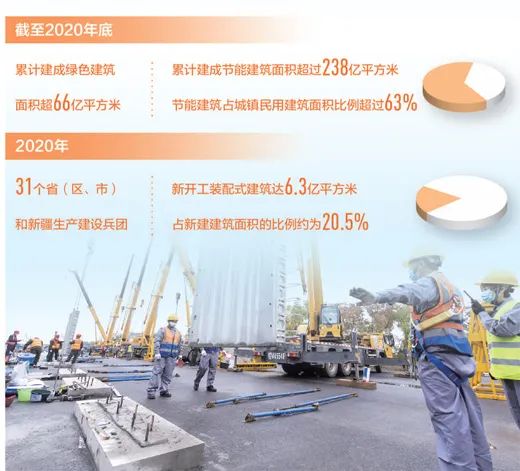Moreover, energy-efficient doors and windows, high-performance concrete, high-strength steel and other building materials, and waterproof technology at the joints of prefabricated buildings all need stronger technical support to improve the energy efficiency of buildings.
For example, the rising cost of construction faces certain financial pressure.
To improve the level of building energy efficiency, we should accelerate the updating of standards for building energy conservation and municipal infrastructure, improve the requirements for energy conservation and carbon reduction, and release the potential for energy conservation and carbon reduction in the construction field.
By the end of 2020, the total green building area in China has exceeded 6.6 billion square meters, making outstanding contributions to reducing carbon emissions.
“The venue adopts carbon dioxide ice making, which can improve the efficiency by 40% compared with conventional refrigerants.
Building energy conservation and carbon reduction face certain challenges.
At the same time, China’s green energy-saving buildings have achieved leapfrog growth.
In the future, we will actively develop external insulation materials with the same insulation effect, but lighter, better fire resistance and longer service life 。” Tian Guomin told reporters.
In addition, China has a large stock of existing residential buildings, and energy-saving transformation needs sufficient financial support.” Tian Guomin said that at present, the government still plays a major role in promoting building energy conservation, the market-oriented promotion mechanisms such as contract energy management, carbon trading and comprehensive energy efficiency services need to be improved, and green financial support is also being explored.
By the end of 2020, the proportion of new green buildings in cities and towns in China had reached 77%, and the accumulated green building area had exceeded 6.6 billion square meters; The total built energy-saving building area exceeds 23.8 billion square meters, and energy-saving buildings account for more than 63% of the urban civil building area.
Colorful aluminum alloy grids cross obliquely.
Under the action of light and shadow at night, they look like falling snowflakes…
“For example, the thickness of external wall insulation materials for building energy-saving transformation has reached 15 cm to 18 cm.
How should we make efforts in the fields of energy, transportation and construction around the green transformation of production and life style? The construction industry is one of the key industries for energy conservation and carbon reduction.
According to the action plan, by 2025, new buildings in cities and towns will fully implement the green building standard.
The action plan for reaching the carbon peak by 2030 previously issued by the State Council proposed to “clarify the objectives and tasks of various regions, fields and industries” and “promote economic and social development on the basis of efficient utilization of resources and green and low-carbon development”.
Wukesong ice sports center, the ice hockey training venue of Beijing Winter Olympic Games, not only has ultra-high “appearance”, but also realizes ultra-low energy consumption.
In addition, the 600 kW photovoltaic power generation panel installed on the roof can realize an annual power supply of about 700000 kWh.” Feng Yanjun, project manager of Wukesong ice sports center of China Construction First Bureau, who participated in the venue construction, said.
In recent years, China’s building energy-saving standards have been steadily improved.
According to estimates, by the end of 2019, China’s new and completed energy-saving buildings can achieve an annual energy-saving capacity of nearly 300 million tons of standard coal, reduce carbon dioxide emissions by 740 million tons, and effectively slow down the growth rate of total building energy consumption.
The action plan mentioned that accelerating urban and rural construction, green and low-carbon development, urban renewal and Rural Revitalization should implement green and low-carbon requirements..
In addition, there are still some bottlenecks in promoting building energy conservation: the society still does not pay much attention to building energy conservation; The extensive construction mode of “massive construction, massive consumption and massive emission” in the field of urban and rural construction needs to be transformed; The development of building energy conservation and green buildings is unbalanced between cities and rural areas, between the eastern coastal areas and the central and western regions, and the policies, standards, technologies and systems to adapt to the characteristics of rural areas need to be improved.
“Building energy conservation has made outstanding contributions to reducing carbon emissions.
Especially after the goal of carbon peak and carbon neutralization is put forward, a systematic and perfect comprehensive evaluation and assessment system for carbon peak and carbon neutralization will be gradually established, which will help the concept of energy conservation and green development to be more effectively implemented in the whole field of construction.” Tian Guomin said.
If the energy-saving standard is further improved, the ‘cotton padded jacket’ on the wall may be thicker.
The “14th five year plan” is a critical and window period for carbon peak.
The action plan for carbon peak before 2030 (hereinafter referred to as the action plan) previously issued by the State Council proposes to accelerate the updating of building energy conservation, municipal infrastructure and other standards and improve the requirements for energy conservation and carbon reduction.
In this way, the risk of falling off and flammability of the insulation layer will also increase.
China’s total construction volume is large.
How is the current progress in improving energy-saving standards in the construction field? What should we focus on next? Green buildings achieve leapfrog growth.
The central economic work conference held at the end of last year proposed that “achieving carbon peak and carbon neutralization is the internal requirement to promote high-quality development”.
Tian Guomin, director of the standard quota Department of the Ministry of housing and urban rural development, introduced that since the promulgation of the first edition of building energy efficiency design standards in 1986, China’s building energy conservation has experienced “three steps”, that is, on the basis of ordinary residential heating energy consumption in the early 1980s, the proportion of building energy conservation has gradually reached 30%, 50% and 65%.
At the same time, technological breakthroughs still need to be continued.
“Improving energy-saving standards means reducing the heat transfer coefficient of windows and thickening thermal insulation materials, which will increase the cost.
It is reported that with the acceleration of urbanization and the improvement of people’s living standards, coupled with the adjustment of industrial structure and the rapid development of the tertiary industry, which mainly relies on buildings to provide service places, China’s building energy consumption intensity and carbon emission intensity will increase significantly.
To save energy and reduce carbon, we should focus on key industries.
For more than 30 years, China has promulgated standards and specifications for residential building energy conservation (five climate zones), public building energy conservation, rural building energy conservation and energy-saving products, forming a relatively systematic energy-saving technology system and standard system.

After ice making waste heat is recovered, it can also be used for hot water supply.
In the future, the construction field will also release great potential for energy conservation and carbon reduction, and there will be no small challenge and pressure to achieve the goal of carbon peak and carbon neutralization.




